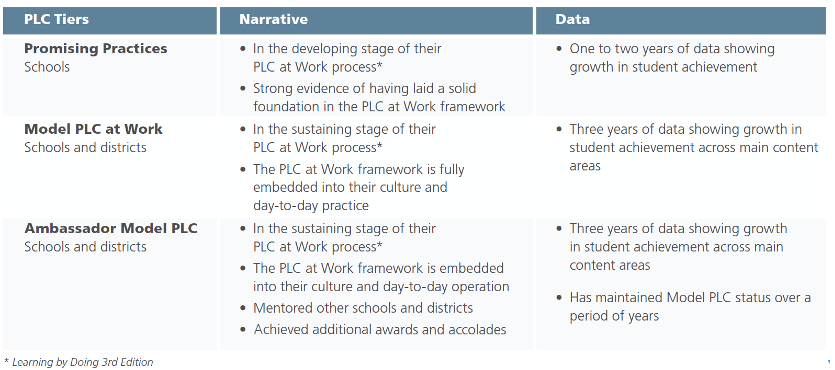Solution Tree recognizes the work of schools and districts that have significantly increased student achievement as a result of implementing the PLC at Work® process. For over 10 years, educational leadership in schools and districts have been invited to submit applications for their professional learning community to become a Model PLC at Work school™ or district recognized for its commitment and fidelity to the Professional Learning Communities (PLC) at Work process. We have expanded Model PLC at Work recognition to include more important milestones on the PLC journey.
Many schools have committed to the PLC at Work process but must wait three years to collect the required data before applying. The Promising Practices tier allows us to recognize and celebrate these early milestones and successes in their PLC journey. This recognition acknowledges the collective efforts and strengthens their commitment as they continue their PLC journey and take the next steps to become Model PLC at Work schools.
The new elite tier of recognition, Ambassador Model PLC at Work status, is for schools and districts that have achieved and maintained Model PLC at Work status and continue to demonstrate their commitment to the PLC at Work process by going above and beyond for the students they serve. They mentor, support, guide, and serve as a pillar to other schools and districts.
These three tiers of awards fall under the DuFour and Eaker Recognition, which honors the architects of the PLC at Work process and expands the original Model PLC at Work recognition.
Three Tiers of DuFour and Eaker Recognition
Promising Practices Schools
Promising Practices is a solid initial step to becoming a Model PLC at Work school. Promising Practices schools have strong evidence of the solid foundation required to become a Model PLC at Work school and share at least one year of data that shows student achievement growth. The Promising Practices tier is for schools only.
Model PLC at Work® Schools and Districts
Model PLC at Work schools and districts have committed to the PLC at Work process, which is ingrained into the day-to-day culture of the school or district. Model schools and districts provide at least three years of data showing evidence of student achievement growth.
Ambassador Model PLC at Work® Schools and Districts
Ambassador Model PLC at Work schools and districts have achieved and maintained Model PLC at Work status and continued their journey by mentoring other schools and districts. Additionally, they may have also received additional awards and accolades. Ambassador schools and districts support, guide, and serve as pillars to other schools and districts.

Why Apply for DuFour and Eaker Recognition?
Celebrating success is a meaningful way to demonstrate what is essential, valued, and expected. It activates the mindset that goals are achievable and deserve to be recognized with high praise.
Becoming a Promising Practices, Model PLC at Work, or Ambassador Model PLC at Work school celebrates and validates the hard work and relentless determination it takes to ensure all students learn. The data and evidence collected on student achievement quantify this success. Becoming a Model PLC at Work school or district is not an easy path, but for that reason, it is the distinction that sets those schools and districts apart.
How to Apply for DuFour and Eaker Recognition?
Solution Tree recognizes schools and districts that follow the Professional Learning Community at Work process and increases student achievement by inviting them to apply for PLC at Work recognition. These schools and districts focus on three big ideas:
- Focus on learning
- Collaborative culture and collective responsibility
- Results orientation
The concept of a Model PLC at Work in schools and districts was created and brought to life by the late Richard and Rebecca DuFour. Richard DuFour and his colleague Robert Eaker were the original architects of PLC at Work. In fact, Adlai Stevenson High School, where DuFour led as principal and superintendent, serves as the first exemplar of this globally recognized achievement.
Steps to achieve PLC at Work status
- Demonstrate a commitment to the PLC at Work process.
- Provide evidence of three years of significant increases in student achievement.
- Present clear evidence of improved student learning.
- Highlight the culture, practices, and structures of your school or district—and, using our online submission process, submit it for consideration to the Evidence of Effectiveness (EOE) Review Committee.
- Update school or district information on the site every three years to show that your data continues to meet the criteria of the PLC at Work process.
Each tier has its own requirements. Please download Model PLC at Work & Promising Practices Applications Guide — DuFour and Eaker Recognition. This document will give you step-by-step instructions, plus tips and recommendations for completing both the Model PLC at Work and Promising Practices applications.
The Review Process
Our Evidence of Effectiveness (EOE) Review Committee reviews every application. This group is comprised of certified PLC at Work associates who volunteer their time to review Model PLC at Work applications.
NOTE: Solution Tree associates must come from a Model PLC at Work school or district, meaning every member on the Evidence of Effectiveness (EOE) Review Committee reviewing applications has led their school or district to Model PLC at Work status and is passionate about the process.
Applications submitted via our online submission process go to the EOE Review Committee. After reviewing your application, you will receive an approval letter, a feedback letter, or a request for additional information.
Whether or not you are ready to receive recognition as a Model PLC at Work, your school or district will receive valuable feedback on your current practices and guidance on how to continue your PLC at Work journey. It is worthwhile to apply, regardless of the eventual outcome. We highly encourage you to seize this opportunity to reflect on where you are in your journey.
So, share your success by applying for one of the DuFour and Eaker Recognition Awards.
